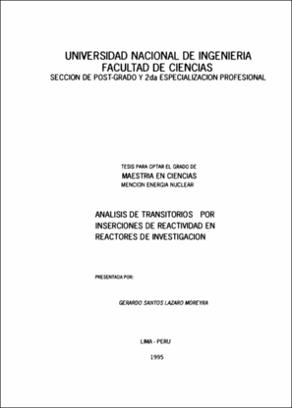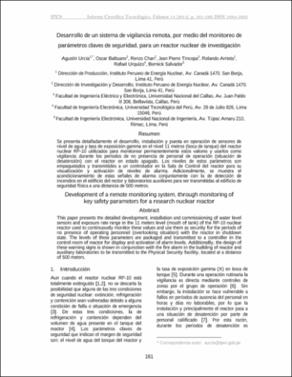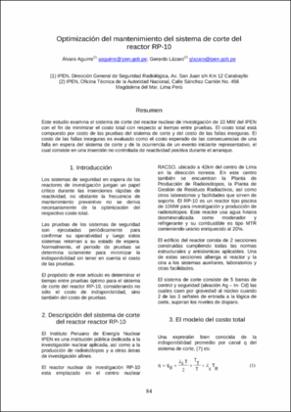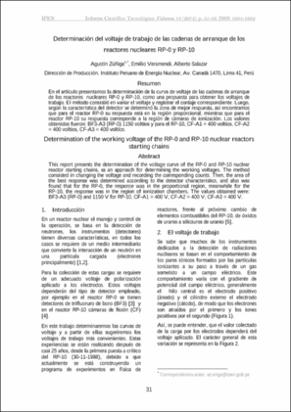Mostrar el registro sencillo del ítem
Análisis de transitorios por inserciones de reactividad en reactores de investigación
| dc.contributor.advisor | Woodruff William L. | |
| dc.contributor.author | Lázaro Moreyra, Gerardo Santos | |
| dc.creator | Lázaro Moreyra, Gerardo Santos | |
| dc.date.accessioned | 2019-12-17T14:09:48Z | |
| dc.date.available | 2019-12-17T14:09:48Z | |
| dc.date.issued | 1995 | |
| dc.identifier.citation | Lázaro Moreyra Gerardo Santos. Análisis de transitorios por inserciones de reactividad en reactores de investigación. [Tesis para optar el Grado de Maestro en Ciencias, Mención Energía Nuclear]. Lima, Perú: Universidad Nacional de Ingeniería, Sección de Postgrado y Segunda Especialización Profesional; 1995. | es_PE |
| dc.identifier.uri | https://hdl.handle.net/20.500.13054/699 | |
| dc.description.abstract | Se estudia la conducta del núcleo de un reactor tipo piscina cuando es sometido a accidentes de excursiones de potencia por inserciones violentas de reactividad. El valor de la reactividad está en el rango de $1.5 a $3.2 insertada en tiempos de 0.10 s a 0.80 s. El valor de $1.5/100 ms es asumido como el caso más desfavorable. Para todos los casos un elemento combustible es arrastrado parcialmente por una de las barras de control y cae al núcleo ligeramente subcrítico en 5 Watts. Estos accidentes se han aplicado a dos núcleos, el A16/21 y el A21/25 los cuales para completar el estudio han sido comparados con los SPERT-1: B24/32, BI6/64 y D12/25. Como el evento iniciante que conduce a la inserción de reactividad es independiente del estado de operación del reactor se ha practicado la simulación al modo de operación más desfavorable en cuanto a las consecuencias del accidente. Este estado de operación se hace a bajas potencias y a convección natural. Ello se confirma con los resultados experimentales de los reactores SPERT I refrigerados por convección natural. El rango de potencia al inicio del accidente varía de 5 Watts a 10 MW y la refrigeración del núcleo de convección natural a convección forzada en 1650 m3/h. Se ha realizado cálculos de importancia de algunas variables de entrada del código con respecto a las consecuencias. Estos datos pueden ser definidos en variables de tres grupos: a) En los datos cinéticos se elige el beta efectivo por ser muy sensible a la configuración de trabajo, b) En transferencia de calor se varía varias opciones de correlaciones de predicción de regímenes de transferencia de calor. Se discute la validez de su acepción para el reactor analizado y e) Con respecto a la ingeniería de seguridad se mantuvo variable el tiempo de inicio efectivo de caída de barras. Esta variable es muy importante porque el retardo del inicio del efecto de las barras de seguridad en la mitigación del accidente es además transcendente para el desarrollo del accidente, aun cuando el peso de los primeros y últimos tramos de las barras de seguridad inducen una pobre reactividad con respecto a su zona central. Estos primeros cm permiten que la reactividad del sistema se mantenga negativa y no ocurra una nueva excursión o, en todo caso, este segundo pico no se desarrolle plenamente tal como sucede con $1.5/800 ms para el núcleo 16 o A16/25. Por otra parte, se ha determinado experimentalmente los parámetros de tiempo de retardo de inicio efectivo de caída de barras; coeficientes de reactividad por generación de vacío y por cambio de temperatura de moderador; tiempo total de inserción de barras y el peso de las barras de seguridad y control para diferentes configuraciones. En todos los casos se asume que los sistemas de control para la protección del núcleo no funcionan, salvo el de disparo de barras de seguridad por alto flujo fijado en 12 Mw. Para este sistema de barras se ha fijado 200 ms de retardo. Este estado de condición de barras puede simular que el reactor trabaje sin sistemas de protección, para ciertos transitorios. Uno de los propósitos del trabajo ha sido investigar la evolución de los parámetros de autocontrol del núcleo en cada uno de los mecanismos de compensación por generación de vacío, por cambio de temperatura de moderador, por cambio de temperatura de combustible y por dilatación de los elementos combustibles. Se cuantifica todas en el transcurso de la evolución del transitorio y se observa graficados la importancia de todas ellas. También se determina la máxima reactividad que puede introducirse al núcleo sin conseguir temperaturas de fusión del revestimiento de la placa o vaina. El código de cálculo empleado para el análisis de estos accidentes es el PARET. La versión original de este programa está cargada en una máquina Digital DEC modelo VAX 11/730. Esta versión original, como parte del desarrollo de la tesis, se implementó como una nueva versión, para la PC-486/DX50. Para este propósito el lenguaje usado en la PC es el Fortran F77L v. 3.0. Antes de empezar con el análisis del tema se validó este código con casos similares de la versión anterior con la VAX y también con el paquete desarrollado en Argonne National Laboratory (USA). Para todos los casos analizados, la similitud de los resultados son los mismos. Se debe mencionar que sin este esfuerzo de implementación del código en una PC no hubiera sido posible hacer un análisis del reactor RP-10 tan exhaustivo como se hace en el presente trabajo de accidentes de este tipo con el PARET. Las razones que motivaron este esfuerzo fueron tiempo y disponibilidad de máquina. Para correr un mismo caso; la VAX 11/730 requiere de un tiempo total de ejecución de 6 h, si es la única tarea que ejecuta. Una PC 486-DXS0 requiere solo 10 minutos. Para casos más tediosos, la VAX requería de más de 10 h de trabajo, lo cual no era posible por razones de cuotas de espacio de disco duro disponible y prioridades con respecto a otras tareas. Por otra parte, en la máquina compatible se tiene una mayor cantidad de utilitarios para el tratamiento de la gran cantidad de datos de salida del PARET. Para este trabajo de tesis todos los gráficos y diagramas han sido hechos con el Sigma Plot 5.0 y el Lotus Freelance Graphics 2.0 for Windows. | es_PE |
| dc.description.abstract | The behavior of the core of a pool-type reactor is studied when it is subjected to accidents of power excursions due to violent reactivity insertions. The reactivity value is in the range of $ 1.5 to $ 3.2 inserted in times of 0.10 s to 0.80 s. The value of $ 1.5 /100 ms is assumed as the most unfavorable case. In all cases a fuel element is partially dragged by one of the control rods and falls to the slightly subcritical core with a power of 5 Watts. These accidents have been applied to two nuclear core configurations, the A16/21 and the A21/25 which to complete the study have been compared with SPERT-1 cores configuration: B24/32, B16/64 and D12/25. As the initiating event that leads to the insertion of reactivity is independent of the state of core working in the reactor, simulation has been carried out at the most unfavorable mode of operation in terms of the consequences of the accident. This state of operation is done at low powers and natural convection. This is confirmed by the experimental results of SPERT I reactors cooled by natural convection. The power range at the beginning of the accident varies from 5 Watts to 10MW and the cooling is with natural convection and with forced convection at 1650 m3/h coolant flow. Calculations have also been made to measure the importance of some code input variables with respect to the consequences. These data can be defined in variables of three groups: a) The kinetic data of effective beta is chosen because it is very sensitive to the configuration of working core, b) In heat transfer, have been chosen several options of correlations of prediction regimes of heat transfer. The validity of its meaning for the analyzed reactor is discussed and, e) With respect to safety engineering, the effective start time of falling control rods was kept variable. This variable is very important due the delay of the beginning of the effect of the safety control rods to control the evolution of the power. To mitigate the excursion of the power it is also transcendent the effectiveness to insert negative reactivity per unit length to control the development of the accident, taking account that the weight of the first and last sections of the safety bars insert poor negative reactivity with respect to its central zone. These first cm allow the reactivity of the system to remain negative and a new excursion does not occur or, in any case, this second peak does not reach fully develop as it happens with $ 1.5/800 ms for core 16 (RP-10) or A16/25. On the other hand, the parameter of the delay time to start the falling control rods have been determined experimentally; reactivity coefficients by vacuum generation and by moderator temperature change; total control rods insertion time and the weight of the safety and control bars for different configurations were determined experimentally. In all cases it is assumed that the control systems for the protection of the core do not work, except the signal for high neutronic flux set at 12 Mw. At which the safety system strip the control rods and this with 200 ms of delay to start the falling of the rods, has been set. This state of condition of control rods simulate that the reactor works without protection systems, for certain transients. One of the purposes of the work has been to investigate the evolution of the parameters of the feedback of self-control of the core in each of the mechanisms of reactivity compensation such the vacuum generation, for change of moderator temperature, for change of fuel temperature and for expansion of the fuels elements. All are quantified in the course of the transient evolution and the importance of all of them is plotted. The maximum reactivity that can be introduced into the core without achieving melting temperatures of the plate or sheath coating is also determined. The calculation code used to analyze these accidents is the PARET. The original version of this program is loaded on a Digital DEC machine model VAX 11/730. This original version, as part of the thesis, it was development and was implemented a new version of the code for a PC-486/DX50. For this purpose the language used on the PC is the Fortran F77L v. 3.0. Before starting with the analysis of the RP-10, this code was validated with similar cases with the original version installed at the VAX and also validated with the package developed in Argonne National Laboratory-USA. For all cases analyzed, the similarity of the results is the same. It should be mentioned that without this effort to implement the new code on a PC, it would not have been possible to make the analysis of the RP-10 as exhaustive as it was done in this work with this type of accident with the PARET. The reasons that motivated this effort were time and machine availability. To run only one same case; The VAX 11/730 requires a total runtime of 6 h. A machine 486-DX50 PC requires only 10 minutes. For more tedious cases, the VAX required more than 10 hours of work, which was not possible due to quotas of hard disk space available and priorities with respect to other tasks. On the other hand, in the 486-DX50 machine there are many of utilities for the treatment of the large amount of PARET output data. For this thesis work the graphs and diagrams have been made with the Sigma Plot 5.0 and the Lotus Freelance Graphics 2.0 for Windows. | |
| dc.format | application/pdf | es_PE |
| dc.language.iso | spa | es_PE |
| dc.publisher | Instituto Peruano de Energía Nuclear | es_PE |
| dc.rights | info:eu-repo/semantics/openAccess | es_PE |
| dc.source | Instituto Peruano de Energía Nuclear | es_PE |
| dc.source | Repositorio Institucional del Instituto Peruano de Energía Nuclear | es_PE |
| dc.subject | Coeficientes de reactividad | es_PE |
| dc.subject | Inserciones de reactividad | es_PE |
| dc.subject | Núcleos de reactor | es_PE |
| dc.subject | Accidentes | es_PE |
| dc.subject | Transitorios | es_PE |
| dc.subject | Componentes del reactor | es_PE |
| dc.subject | Reactor RP-10 | es_PE |
| dc.subject | Reactores de investigación | es_PE |
| dc.title | Análisis de transitorios por inserciones de reactividad en reactores de investigación | es_PE |
| dc.title.alternative | Transient analysis by reactivity insertions in research reactors | es_PE |
| dc.type | info:eu-repo/semantics/masterThesis | es_PE |
| dc.publisher.country | PE | es_PE |
| thesis.degree.discipline | Energía Nuclear | es_PE |
| thesis.degree.grantor | Universidad Nacional de Ingeniería. Facultad de Ciencias | es_PE |
| thesis.degree.name | Magister en Ciencias mención Energía Nuclear | es_PE |
Ficheros en el ítem
Este ítem aparece en la(s) siguiente(s) colección(ones)
-
Tesis de Postgrado [11]








